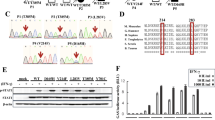Abstract
Although toxicity and inborn errors of metabolism may also be involved, immunological reactions play an important role in the induction of drug-induced agranulocytosis. Drug-induced antibodies may lead to agranulocytosis by at least three different immunological mechanisms. Immune complexes may selectively adhere to granulocytes or their immature precursor cells, the drug may bind to the granulocytes as carriers of the immunogenic drug and finally the drug may induce antibodies directed to granulocyte-specific structures. The use and the interpretation of in vitro assays to detect drug-dependent antibodies against granulocytes or myeloid precursor cells are discussed. These assays will be used to detect a possible immunological mechanism involved in clozapine-induced agranulocytosis. Further studies will concern the identification of possible genetic risk factors associated with clozapine-induced agranulocytosis.
Similar content being viewed by others
References
Ackroyd JF (1949) The pathogenesis of thrombocytopenic purpura due to hypersensitivity to sedormid. Clin Sci 7:249–262
Batchelor JR, Welsh KI, Tinoco RM, Dollery CT, Hughes CT, Bernstein P, Ryan P, Naish PF, Aber GM, Bing RF, Russell GI (1980) Hydralazine-induced systemic lupus erythematosis: influence of HLA-DR and sex on susceptibility. Lancet I:1107–1109
Breimer DD (1982) Interindividual variations in drug disposition. Clinical implications and methods of investigation. Clin Pharmocokinet 8:371–377
Claas FHJ (1987) Drug-induced immune granulocytopenia. Baillières Clin Immunol Allergy 1:357–368
Claas FHJ, Van Rood JJ (1985) The interaction of drugs and endogenous substances with HLA class I antigens. Prog Allergy 36:135–150
Claas FHJ, Van der Meer JWM, Langerak J (1979) Immunological effect of cotrimoxazole on platelets. Br Med J 2:898–899
Claas FHJ, Langerak J, Van Rood JJ (1981) Drug-induced antibodies with restricted specificity. Immunol Lett 2:323–326
Claas FHJ, Langerak J, Van Vreeswijk W, D'Amaro J, Van Rood JJ, Balner H (1983) Platelet- and granulocyte specific allo-antigens in chimpanzees. Tissue Antigens 22:219–226
Claas FHJ, Blankert JJ, Rooduyn-Moerel L, Van Rood JJ (1984) Influence of non-H-2 genes on the in vivo response to penicillin treated autologous platelets. J Immunogenet 11:319–326
Duran-Suarez JR, Martin-Vega C, Argelagues E, Massuet L, Ribera A, Triginer J (1981) Red cell I antigen as immune complex receptor in drug-induced hemolytic anemias. Vox Sang 41:313–315
Eisner EV, Shahidi NT (1972) Immune thrombocytopenia due to a drug metabolite. N Engl J Med 287:376–381
Fibbe WE, Claas FHJ, Van der Star-Dijkstra W, Schaafsma MR, Meyboom RHB, Falkenburg JHF (1986) Agranulocytosis induced by prophylthiouracil: evidence of a drug dependent antibody reacting with granulocytes, monocytes and haematopietic progenitor cells. Br J Haematol 64:363–373
Guffy MM, Goeken NE, Burns PC (1984) Granulocytotoxic antibodies in a patient with prophylthiouracil-induced agranulocytosis. Arch Int Med 144:1687–1688
Habibi B (1985) Drug-induced red blood cell autoantibodies codeveloped with drug specific antibodies causing haemolytic anaemias. Br J Haematol 61:139–143
Huguley CM (1964) Drug-induced blood dyscrasia: agranulocytosis. JAMA 188:817–824
Kelton JG, Huang AT, Mold N, Logue G, Rosse WF (1979) The use of in vitro technics to study drug-induced pancytopenia. N Engl J Med 301:621–624
Kunicki TJ, Russell N, Nurden AT, Aster RH, Caen JP (1981) Further studies of the human platelet receptor for quinine and quinidine-dependent antibodies. Immunol 126:398–402
Lader M, Kendell R, Kariel J (1974) The genetic contribution to unwanted drug effects. Clin Pharmacol Ther 16:343–348
Levine BB (1965) Induction of immune response and the role of antibody specificity in drug-hypersensitivity-type hemolytic anemia and thrombocytopenia. Semin Hematol 2:338–346
Madison FW, Squier TL (1934) The etiology of primary granulocytopenia (agranulocytic angina). JAMA 102:755–763
Magis C, Thierfelder S, Saint-Paul M, Dausset J (1962) Etude Serologique d'une agranulocytose allergique à l'aminopyrine. Nouv Rev Fr Hematol 2:602–610
Martelo OJ, Katims RB, Yunis AA (1967) Bone marrow aplasia following propylthiouracil therapy. Arch Int Med 120:587–590
Martinez L, Letona J, Barbolla L, Frieyro E, Bouza E, Gilsanz F, Fernandez MN (1977) Immune haemolytic anaemia and renal failure induce by streptomycine. Br J Haematol 35:561–571
Miescher PA, Jaffé ER (1973) Conclusion. Semin Hematol 10:351–352
Miescher PA, Miescher A (1978) Immunological drug-induced blood dyscrasias. Klin Wochenschr 56:1–58
Moeschlin S, Wagner K (1952) Agranulocytosis due to the occurence of leucocyte-agglutinins. Acta Haematol 8:29–41
Murphy MF, Riordan T, Minchinton RM (1983) Demonstration of an immune-mediated mechanism of penicillin-induced neutropenia and thrombocytopenia. Br J Haematol 55:155–160
Murphy MF, Metcalfe P, Grint PCA, Green AR, Knowles S, Amess JAL, Waters AH (1985) Cephalosporin-induced immune neutropenia. Br J Haematol 59:9–14
Panayi GS, Wooley P, Batchelor JR (1978) Genetic basis of rheumatoid disease: HLA antigens, disease manifestations and toxic reactions to drugs. Br Med J 2:1326–1329
Pegels JG, Von dem Borne AEG, Thomas LLM, Tytgat GN, Engelfriet CP (1980) Autoimmune granulocytopenia; possibly associated with levamisole therapy. Clin Lab Haematol 2:339–347
Petz LD, Fudenberg HH (1975) Immunologic mechanisms in drug induced cytopenias. Prog Haematol 9:185–206
Pisciotta AV (1973) Immune and toxic mechanisms in drug-induced agranulocytosis. Semin Hematol 10:279–310
Rosenthal N (1928) The blood picture in purpura. J Lab Clin Med 13:303–315
Salama A, Mueller-Eckhardt C, Kissel K, Pralle H, Seeger W (1984) Ex vivo antigen preparation for serological detection of drug-dependent antibodies in immune haemolytic anemias. Br J Haematol 58:525–531
Salama A, Mueller-Eckhardt C (1985) The role of metabolite-specific antibodies in nomifensine-dependent immune hemolytic anemia. N Engl J Med 313:469–474
Shulman NR (1964) A mechanism of cell destruction in individuals sensitized to foreign antigens and its implication in autoimmunity. Ann Intern Med 60:506–521
Thompson JS, Herbick JM, Klasen LW (1980) Studies on levamisole-induced agranulocytosis. Blood 56:388–396
Verheugt FWA, Von den Borne AEGKr, Van Noord-Bokhorst JC, Nijenhuis LE, Engelfriet CP (1978) ND1, a new neutrophilgranulocyte antigen. Vox Sang 35:13–22
Vessel ES (1977) Genetic and environmental factors affecting drug disposition in man. Clin Pharmacol Ther 22:659–679
Veys EM, Mielants H, Verbruggen G (1978) Levamisole-induced adverse reactions in HLA-B27 positive rheumatoid arthritis. Lancet I:148–150
Weitzman SA, Stossel TP, Desmond M (1978) Drug-induced immunological neutropenia. Lancet I:1068–1072
Worlledge SM, Carstairs KC, Dacie JV (1966) Autoimmune haemolytic anaemia associated with § methyldopa therapy. Lancet II:135–139
Author information
Authors and Affiliations
Rights and permissions
About this article
Cite this article
Claas, F.H.J. Drug-induced agranulocytosis: review of possible mechanisms, and prospects for clozapine studies. Psychopharmacology 99 (Suppl 1), S113–S117 (1989). https://doi.org/10.1007/BF00442574
Issue Date:
DOI: https://doi.org/10.1007/BF00442574




